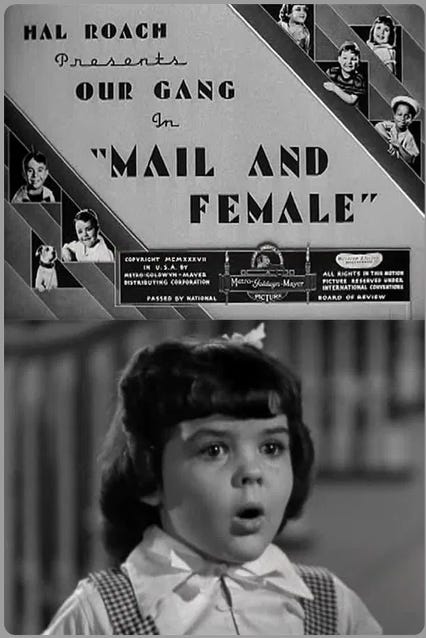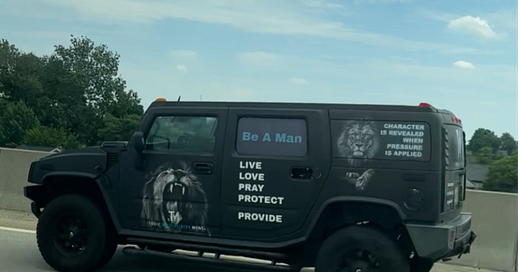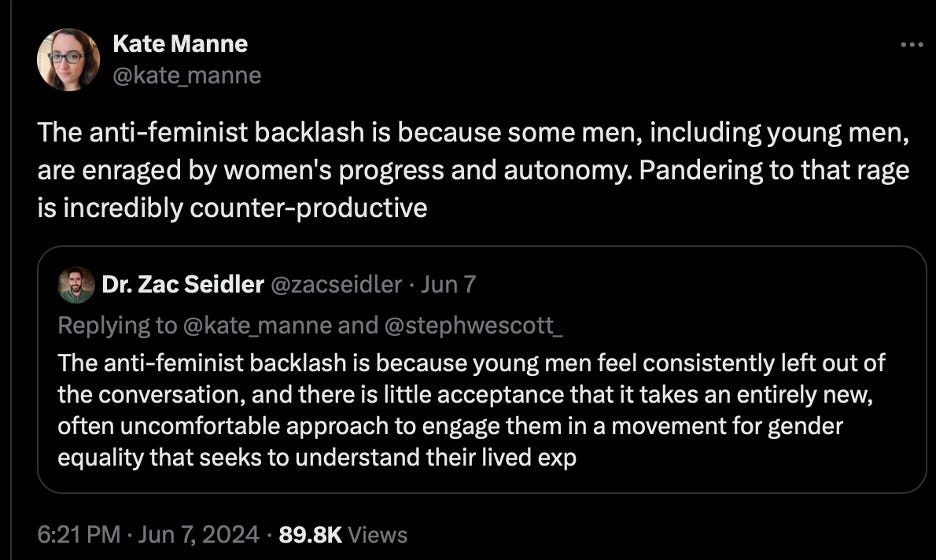Who Says Masculinity Is Toxic?
questions and thoughts from a dissident feminist/non-feminist/anti-feminist/boymom
Earlier this year, while traveling north on the Garden State Parkway, a Jeep with an interesting motif caught my attention. It’s not easy to make out, but there’s a logo overlaying the lion image—“TM” and then the words “Toxic Masculinity Mens”—which I immediately looked up (Author’s note, I was a passenger). The TM website announces: Haircare•Apparel•Barbering, but its mission statement is a bit more involved.
I’m not fully versed in TM’s philosophy and unsure if I embrace their full manifesto, but I’ve long thought the term “toxic masculinity” is much overused. And I do have thoughts.
This Substack began after I’d been digging around the 1970s and happened on the media treatment of two issues of Playboy from 1979 that made unmistakable the stigmatization of an entire cohort of young women by feminist thought leaders of the day. Icons of the women’s movement imposed their own ideas about female identity and female possibility onto hopeful young women just emerging, newborn and shaky-legged, into the world of freedom that was promised to them. The world wasn’t quite so free. To keep those young women inline, the women associated with Playboy—the Bunnies, the Playmates—were stereotyped and stigmatized.
I’d always sensed that the charge against Playmates (they’d been pedaled by the magazine as nothing more than commodities) was untrue.
’s The Open Journal launches readers into positivity every Monday with her thoughts and poetry; she’s the same woman who’s been closely associated with Playboy since 1989, having appearing on more covers than any other model. These women were never cardboard cutouts, but as Camille Paglia called it, Playmates were expressing something larger than Playboy; a “flamboyant femaleness,” and that was untenable to second wave feminists. And that mattered. If that wasn’t a route that every young woman wanted to take for herself, it wasn’t for feminists or anyone else to shame every young woman away from it.Forging ahead with the essay, in the back of my mind, a few peripheral questions began to percolate. What were the other narratives that might not be true? What about the narratives about men?
Like anything that requires balance, the rise of female identity had a direct influence on male identity although it would be decades before we had names for the shifting cultural tides. What was called the patriarchy and misogyny became toxic masculinity. There was never any thought as to how those labels would land or the possibility that the very success of marking masculinity as a negative would be damaging to our sons and our brothers and all the young men we care about. A crisis for young men.
It's an issue we’re now wrestling with. But here’s the thing. Back in June, once my attention was directed to TM’s highly decorative Jeep, my mind didn’t go to the Man vs. Bear meme or a podcast episode about a quiet revolution against modern feminism. What came to mind was an episode of the Little Rascals that I’d last seen in the early 1970s.

“Mail and Female,” was originally released on November 13, 1937, but if you grew up in the New York Metropolitan area in the 1960s and ‘70s, these classics shorts played as a seemingly endless loop on WPIX Channel 11 and were a staple of our childhoods.
In this popular episode, the “Our Gang” boys, irked by the MacGillicuddy sisters, who’ve hosted a party where only girls had been invited, form the exclusive “He-Man Woman-Haters Club” in revenge. Membership requires no association whatsoever with girls, which is where plans go awry with Alfalfa having just penned a note to his love interest, Darla, a note which he desperately hopes to retrieve.
The stated premise of the club (“No girls allowed”) differs on its face from TM’s definition of masculinity (“Live, Love, Pray, Protect and Provide”). Still, the “He-Man Woman-Haters Club” floated into my thoughts, likely because there’s something so visceral in the words, they could have been applied to a Jeep with a lion and a logo about alpha masculinity. That’s been the plug on a type of hyper maleness that so many see as a cultural norm (Man vs. Bear). But what really had me thinking was how much the Little Rascal’s episode was a parody mocking that hyper maleness—not only mocking it but mocking it in a children’s show. That’s how ludicrous that sort of masculinity was seen across the culture going back almost ninety years.

And yet today we talk about hyper maleness as if it’s a thing that exists and is thriving. That’s where I landed, considering the Jeep I had seen and the podcasts I’d been listening to and the essays I’d been reading. Thinking more about the longform essay I’d just written and how it threads into a much-needed discussion of masculinity.
If I learned anything looking back on the 1970s, it was that the progress of the women’s movement was never linear. The decade was the conduit between the before and after of sweeping social change, and it was terribly complex. Here’s a small sampling, an amuse-bouche of the times. A full five years after Roe vs. Wade had been decided and after Billie Jean King had her triumph in the “Battle of the Sexes,” courts were still debating whether a man could be criminally prosecuted for raping his wife.
The Rideout case was notable for taking place in Oregon, where a law protecting spouses had been passed in 1977. “In 49 other states, [John] Rideout would not have been arrested. He would have been protected by immunity laws making marriage or cohabitation a defense against rape.”
That the Oregon law had been passed, and that the Rideout case was making national news, is a window on where American culture had been and where it was going. It’s the kind of media firestorm I’ll be exploring in a new, multi-part series, which looks at masculinity and what’s now often referred to as the male crisis. Open questions on discrimination and which gender is currently taking the bigger hit are rooted in the move for women’s rights of the 1970s, and I’ll use cultural touchstones from the disco era as a looking glass. Was Dirty Harry a misogynist? Were young men, in particular, caught between Rust Belt economics and the era’s social changes? How should we look at Luke and Laura’s story line from General Hospital in the wake of #MeToo? The first issue will be out on September 26.
Episode Notes
This Week’s Recommended Watching
This Week’s Recommended Reading
Quotes from Arthur Kretchmer, longtime editor at Playboy on Asa Baber who wrote the “Men” column:
He was a pioneer in saying there were men's issues, and he also told men not to hide from their issues... [it] helped a lot of guys deal with things that men think of as weaknesses: depression, the pain of divorce, the pain of unemployment, the pain of rejection.
— Arthur Kretchmer
Women who worked at the magazine hated the column or were embarrassed by the notion that a man would stick up for men, would go out of his way to say that men had character, men had virtues, men had their own sets of needs and that men were also asked to make sacrifices by the culture that they lived in that were minimized by the women's movement: going to a job every day, serving in the military.
— Arthur Kretchmer
This Week’s Music
"Dirty Work" by Steely Dan (on Spotify and Amazon Music).
Just One More Thing
All questions and comments welcome, but here is a question for this week:
Is there a book or a movie or a cultural moment that defines the 1970s for you? Please share.











I love the novel Chilly Scenes of Winter by Ann Beattie
I'm really looking forward to your series! I think about this a whole lot but have never really worked through it completely. What I do know is men need to be celebrated for the many virtues that they tend to have, and they generally are not.